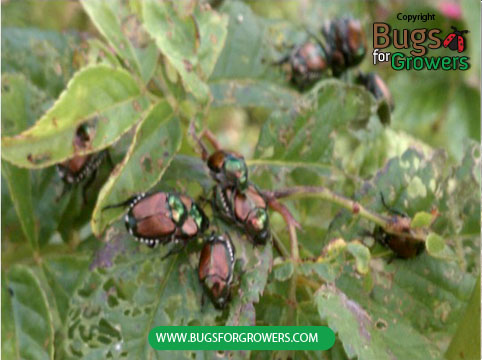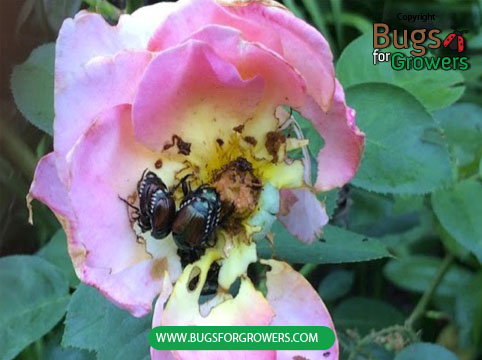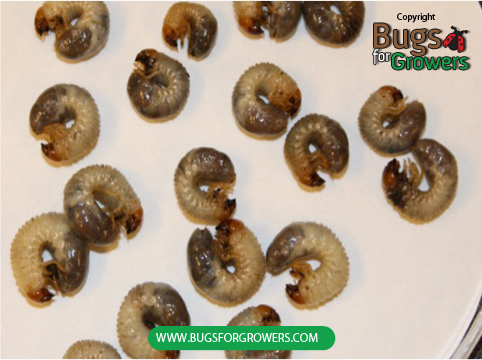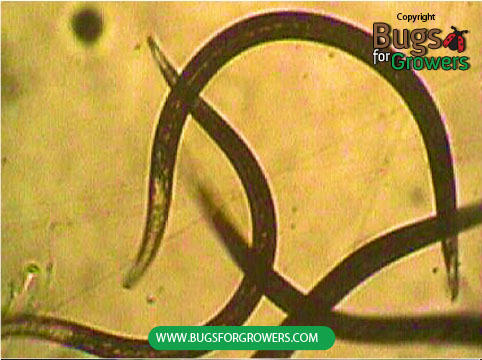To stop incidence of future generations of Japanese beetles (Popillia japonica), treat turfgrass with beneficial entomopathogenic Heterorhabditis bacteriophora nematodes twice in a year. First application of beneficial nematodes should be carried in the late April or early May to target and kill mature grubs and pupae of Japanese beetles so that the emergence of their adults will be stopped and their life cycle will be discontinued. Second application of beneficial nematodes should be carried out in the month of August to target and kill young grubs before they become mature (third instar) and move deep into the soil for overwintering.
However, it is important to know the exact timing of application of beneficial nematodes that coincides with the timing of occurrence of vulnerable stages including young and mature grubs, and pupae of Japanese beetles in their life cycle (see below).
Life cycle of Japanese beetles and appropriate timings for the application of beneficial nematodes
The life cycle of Japanese beetles begins when adult beetles emerge from pupae in the month of July and it contains four developmental stages including eggs, grubs, pupae and adults. Adult-to- adult life cycle of Japanese beetles is usually completed in a year as described below in a chronological order (read this fact sheet from Department of Entomology, University of Minnesota on life cycle of Japanase beetles).
July: Metallic green colored adults of Japanese beetles emerge from pupae and start feeding on leaves (Photo 1), flowers (Photo 2) and small fruits of their host plants. While feeding, they mate and females lay whitish eggs in the soil near to the root zone of host plants. These eggs hatch within a week into small creamy colored grubs that begin feeding on small roots of host crops mainly turfgrass.


August: Throughout August, first generation grubs of Japanese beetles feed on the grass roots and develop through different stages (instars) and become mature (3rd stage/instar). Mature grubs are creamy whitish in color and “C” shaped (Photo 3).

Why is August the best month for the application of beneficial nematodes?
Assuming that the beneficial nematodes applied in late April or early May did not stop the emergence of the new generation of adults of Japanese beetles, second application of beneficial entomopathogenic Heterorhabditis bacteriophora nematodes (Photo 4) in the month of August is needed to target and kill young grubs before they become mature (third instar) and move deep into the soil for overwintering.
When beneficial nematodes are applied to the turfgrass, they will enter in the soil where they will find, infect and kill all the young grubs of Japanese beetles so that they will not mature, move deep in the soil to avoid harsh winter conditions and emerge as adult beetles in the next spring.

For effective control of all stages of grubs, it is recommended to apply 25,000 beneficial nematodes per square foot area using water cans with sprinkler heads (Photo 5). When nematodes locate Japanese beetle grubs, they will enter into their body cavity via natural openings like mouth, anus and breathing pores.
Once in the body cavity, nematodes release symbiotic bacteria called Photorhabdus luminescens in the grub’s blood where bacteria multiply and cause septicaemia and kill grubs within 48 hours after infection. However, if young stages of grubs are not killed by application of nematodes in August, they will continue feeding on roots of grass until they become mature.

September: Third stage (mature) grubs continue feeding on grass roots if they are not killed by nematodes.
October: When temperature begins cooling down to 60oF (16oC), mature grubs reduce feeding activity and also begin moving deep (between 2 and 8 inches depth) in the soil for overwintering.
November: When temperature falls to 50oF (10oC), grubs stop feeding, become inactive and move into overwintering mode.
December: Grubs continue overwintering deep in the soil.
January: Grubs continue overwintering deep in the soil.
February: Grubs continue overwintering deep in the soil.
March: When temperature begins warming up above 50oF (10oC), grubs start moving upwards back into the grass root zone.
Why is April the best month for application of beneficial nematodes?
April: Since mature grubs have already moved up into the turfgrass root zone from overwintering sites and resumed their feeding on turfgrass roots, first application of beneficial nematodes should be carried in the late April or early May as described above to target and kill mature grubs so that there will no formation of pupae of Japanese beetles so that the emergence of adults of Japanese beetles will be stopped and their life cycle will be discontinued.
May: Mature grubs will continue feeding on turfgrass roots if all of them are not killed by beneficial entomopathogenic Heterorhabditis bacteriophora nematodes that are applied in late April or early May. However, there is a possibility that applied nematodes will recycle themselves in the killed grub cadavers and kill all the mature grubs before they form pupae.
June: Mature grubs will turn into pupae, if all of them are not killed by beneficial nematodes that were applied in late April or early May. However, applied nematodes will generally recycle themselves in the killed grub cadavers and their infective juveniles will infect and kill all the pupae in the soil so that the emergence of adults of Japanese beetles will be stopped and their life cycle will be discontinued.
July: If all the pupae are not killed by beneficial nematodes in June, adults of Japanese beetles will emerge from pupae and life cycle continues.
